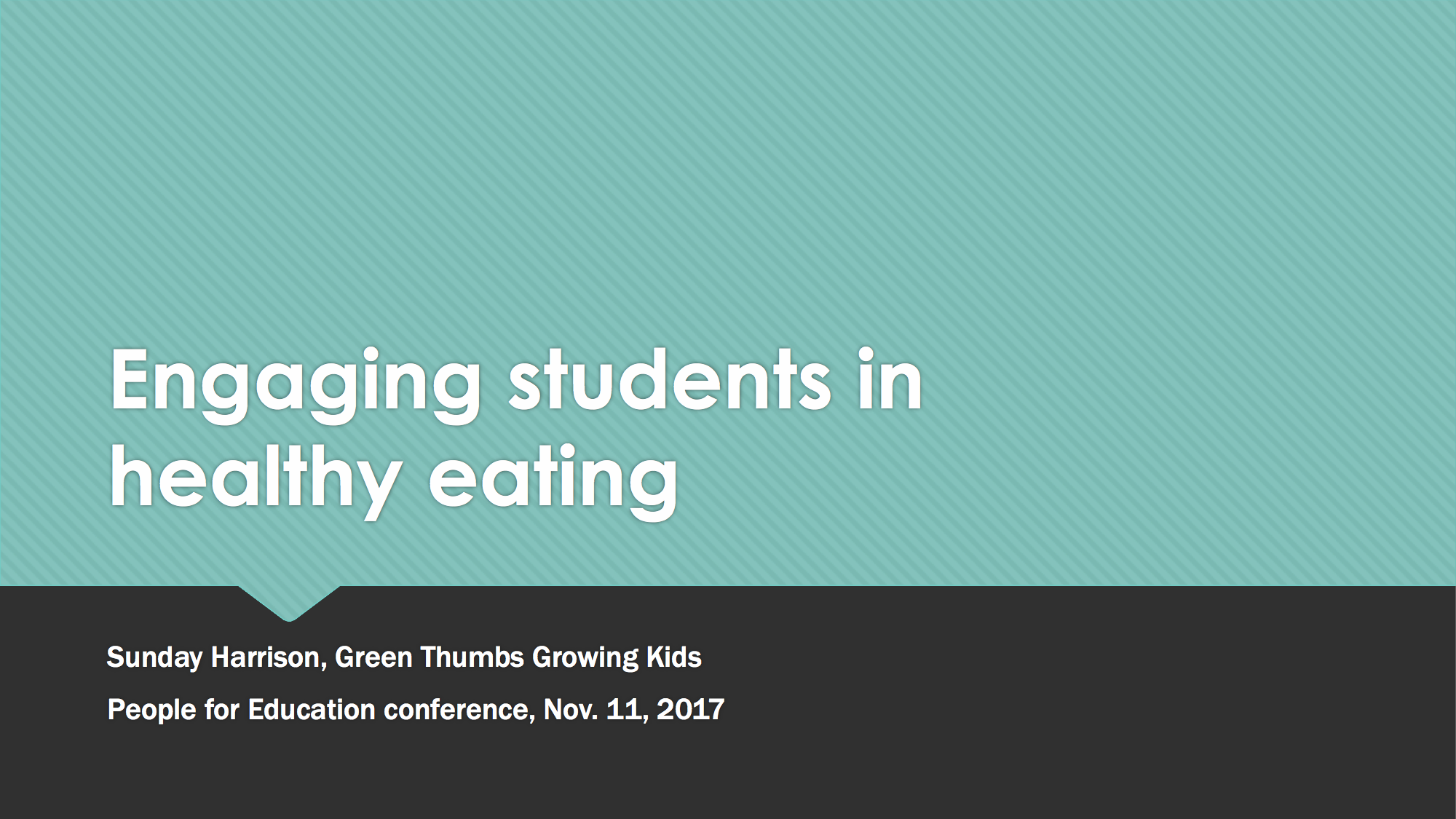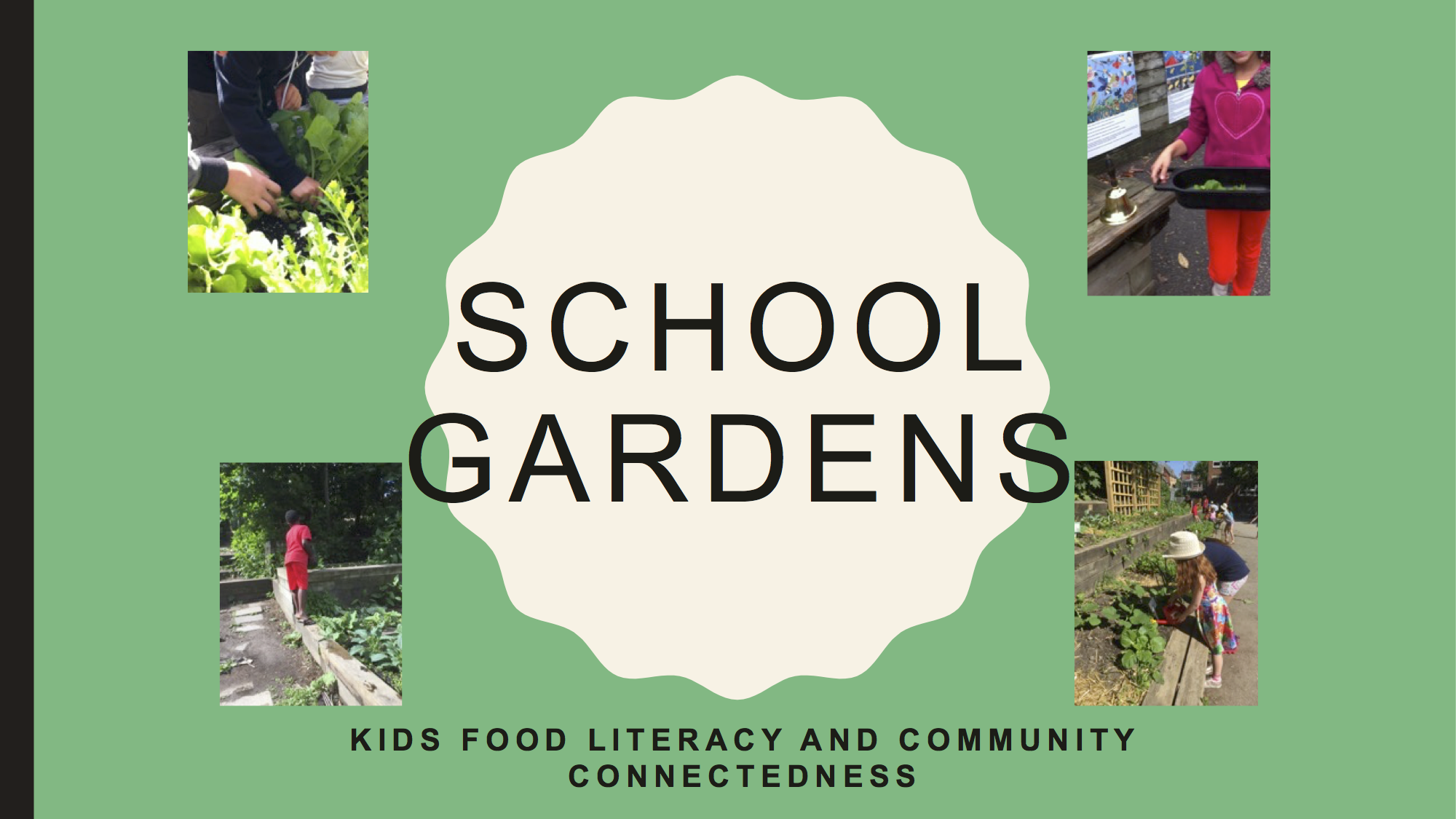Notes from our Making Connections Conference 2017
There’s more than one way to peel a carrot!
Engaging students in healthy eating.
Speakers:Sunday Harrison: Founder and Executive Director of Green Thumbs Growing Kids Liz Lundy: Teacher-librarian who is integrating the school garden into the curriculum Stefan Sommer: Former caretaker, founder of the Urban Farming Innovation Project Moderator: Agata Rudd, Development Manager, Escarpment Biosphere Conservancy & PFE volunteer |
Overview:How can we get kids to eat their veggies? School-based food programs can do more than just provide a good meal and support student health. By increasing students’ food literacy, these programs can help to develop lifelong healthy eating habits, and increase school and community connectedness. And they also support student learning and success! Learn more about the amazing programs schools are using to engage kids in healthy eating, by involving them directly in growing, preparing, and enjoying healthy foods. |
Presentations
Click the panelists names to see notes from their presentations
A large problem facing schools and children today is health. Naturally, children do not gravitate towards fresh produce. This is a growing problem since widespread obesity is a major health concern, where part of the problem is low consumption of healthy produce. The World Health Organization (WHO) states that more than half of annual spending in Canada is spent on treatment of chronic diseases stemming from unhealthy eating, physical activity, etc.
Canada is one of the only industrial countries without a national school food program (however, there are rumours that a food program is coming soon through the Ministry of Agriculture). With almost no policy on healthy eating in Canada, 1 in 6 children are food insecure, and 2 in 3 Inuit children are food insecure.
In the Ontario curriculum, mention of food and healthy living is limited to Phys. Ed and the Specialist High Skills Major (SHSM) program in Culinary Arts and Horticulture. The main information children receive about food, comes from the Canada Food Guide, which was heavily based on food marketing influences and is currently under revision for 2018 release.
The environmental policy framework states that students will understand the connection between food, water, and ecosystems, etc. Unfortunately, there are no instructions for teachers to actually teach this information, and no funding is available to propagate these ideas.
Solution: Growing a Garden
When thinking about creating a school garden, one issue that arises is that school grounds are not deemed instructional space. Starting and maintaining a garden requires funding, which may be difficult to get from schools/boards since gardening is not seen as part of the curriculum.
However, research has shown that when children are involved in gardening at their school it has a positive impact on student mental health, decreases bullying and aggressive behaviour, lessens student anxiety, and students visit the school nurse less frequently. Students also show a willingness to try new foods, their academic achievement increases (especially in the sciences), and their social and emotional development is supported.
Green Thumbs Growing Kids is an organization (Sunday Harrison is the executive director) that has been running school garden and food literacy programs in elementary schools since 2000. The food from the gardens is used in the school’s cafeteria, where everything is made from scratch. Sunday also works as a consultant, helping teachers bring the garden and healthy eating into the curriculum in almost all subjects. In math, they use gardening measurements and dimensions to help optimize garden space. Students organize and label the gardens using art. In science, they study the chemistry of gardening, using principles from chemistry and biology to support the learning of plants, life, cells, and ecosystems.
Liz Lundy is a core French teacher and teacher librarian at Ossington Old Orchard Park School. Liz runs the garden at her school and uses the garden in her teaching. She bases her French class on gardening in the months that the garden is usable. Liz creates activities where students have the opportunity to taste, test, and share different vegetables, and herbs from the garden. Ossington Old Orchard hosts several harvest celebrations throughout the year to bring together the students, their families, and the community. Liz shared several of her students’ experiences with us, telling us that parents will contact Liz asking her what she did to make their kids love kale, and even ask to put it on the family’s grocery list. “A kid will never not eat something they’ve grown themselves”, she explained, quoting Jamie Oliver.
The community plays a large role in the maintenance of a school garden. A lot of gardening is not expensive, but time consuming. So parents who can afford to buy materials do that, and parents who have time to help give their time to build, weed, or water, even over the weekend. Often, Liz doesn’t have to plan a watering or weeding schedule anymore, because when people come to hang out, they end up doing it anyways. When it comes to watering, Liz says sometimes she will just leave a huge water container by the garden with 10-15 watering cans at 8am. By noon, the entire garden is watered, thanks to students on their recess or just walking by.
| At York Humber High School, Stefan Sommer runs a gardening program, but indoors, using hydroponic towers. This allows him and students to grow all year long, although the number of things they can grow indoors is a bit more limited. Stefan works with low-functioning students, and has found that using these towers has piqued their interest in school again. Since hydroponic towers don’t require weeding, and the towers are accessible, it allows students in wheelchairs to have their first gardening experiences. Watch a short video about the Urban Farming Innovation Project. |
Audience questions/concerns/final thoughts
Gardening is a multi-age, community building project. Liz uses older students to create a buddy system with younger students to teach kindergarteners how to garden and tend to plants, and teach older students about mentorship. Thanks to the Bengali parents in the community, Sunday learned you could cook and eat sweet potato greens in June and then harvest the actual potato in the fall, so that none of the plant is wasted.
To solve the problem of maintenance during the summer, Sunday runs a youth volunteer program, Liz uses the community to help with upkeep, and Stefan hires students for summer jobs to maintain the towers.
The connection to food occurs when the kids have grown food themselves. Their interest, their learning, and sustainability stems from them being able to do it themselves.
At the end of the session there was some concern from audience members that administration would not be interested, would not see the benefits, and would not prioritize it (which the speakers said was absolutely necessary).


